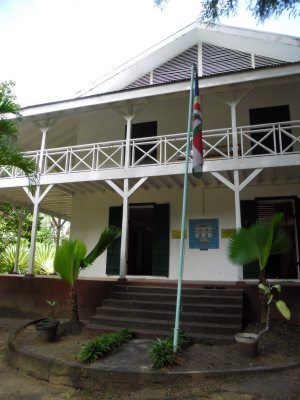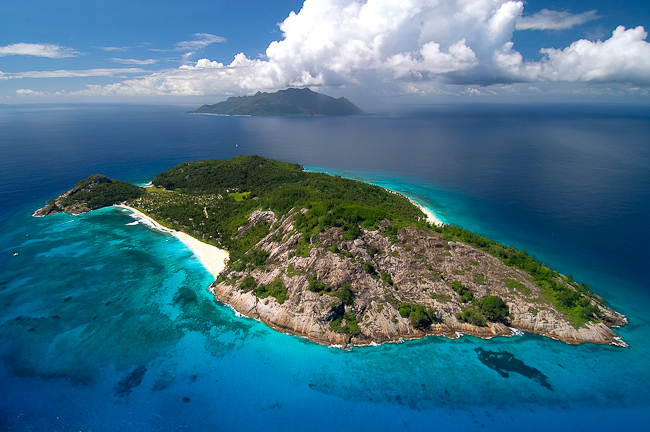Curieuse lies just off the north-western coast of its close neighbour Praslin
and is now a reserve managed by the Seychelles Centre for Marine Technology -
Marine Parks Authority.
It all started a bit nasty
for settlements on Curieuse. Here, it is much drier than on Praslin - and
especially Mahé - as it rains a little bit less and more importantly because the
soil cover is too small to store much ground water. Poor soils in general made
agriculture a bad idea on Curieuse.
Once known as Ile Rouge on account of its red
earth, Curieuse was eventually named after one of explorer Marion Dufresne's
vessels which explored the islands of the Praslin group in 1768.
This
rugged island was once home to a leper colony situated at Anse St. Joseph, and
whose resident doctor's house dating back to the 1870's has recently been
converted into an eco-museum and visitors centre.
Aside from Praslin,
Curieuse is the only other island where the Coco-der-mer grows naturally, and
also boasts an endemic vine and eight different species of
mangrove.
Today Curieuse is home to an exciting giant land tortoise
rearing project. The island is also an important nesting site for hawksbill
turtles.
No accommodation is offered on this island, but excursions can
be arranged through local ground handling operators, and Seychelles Yacht Charter regularly visits Curieuse on charters where it affords guests the opportunity to visit the tortoise sanctuary, and take the mile long hike across across the island, through the nature reserve, and on to the former leper colony where one can visit the doctor's house and museum. It truly is a great day out!
Photos from Curieuse...
North lies only a few kilometres north of Silhouette and is the smaller of two
visible in the distance from the beach at Beau Vallon on Mahé.
North was
one of the very first Seychelles islands to be visited in a 1609 expedition
under Captain Alexander Sharpeigh who found the island to have excellent ‘cokker
nutts’ (i.e. coconuts) as well as a thriving population of giant land
tortoises. From 1826 until the 1970s, North Island was owned by the Beaufond family from Reunion. During this time the island was a plantation for growing fruit and spices, as well as producing guano, fish oil and copra. After the plantation was sold in the 1970s, the island fell into disuse, and was taken over by feral animals and alien species of weeds
Widely regarded as one of Seychelles' most fertile islands,
until recently North had been inhabited by smallholders producing vegetables,
tending and harvesting the coconut plantations for shipment to Mahé, and
engaging in fishing.
In 2003 Wilderness Safaris (a South African comoany) opened an 11-chalet,
five-star resort on the island targeting the luxury eco-tourism market,
promising visitors interaction with the island’s biodiversity at the same time
offering a high standard of barefoot luxury.
The management is remaking
the island into a wildlife sanctuary it dubs the “Noah’s Ark” project, a
long-term plan to rehabilitate the island’s habitats to what it was before the
introduction of human settlement, and to introduce endangered flora and fauna on
the island to help preserve some of Seychelles’ precious endemic
species. It is one of the most ambitious conservation projects ever undertaken by a private company.
Photos from North Island...
Many thanks to www.seychelles.travel.sc
Situated approximately 55km from Mahé, Frégate and is the most distant of the
granitic Inner Island group. It was a popular pirate haunt during
the latter part of the 17th century and stories persist of treasure hidden
somewhere on its 280 hectares, although I am yet to confirm those stories!
A three-kilometre square fragment splintered from the prehistoric ark-continent of Gondwana, which once united South America, Africa, India and the Antarctic: like much of the Seychelles, Frégate Island remained beyond the reach of the major evolutionary developments, and man, for hundreds of millions of years. This allowed secluded pockets of untouched nature to flourish.
The Seychellois magnate Harry Savy
purchased the island after World War II, transforming it into a highly
profitable venture by growing vegetables, fruit, coffee, vanilla, cinammon and
poultry for markets on Mahé. The island sustained a population of some 100
persons, busily engaged in Savy’s several lucrative enterprises.
The island is home to no less than fifty
species of birds, among which is the rare Seychelles magpie robin, and also
hosts the world’s only population of the giant tenebrionid beetle as well as
numerous giant tortoises.
Frégate features a luxurious five-star
eco-lodge offering the optimum in comfort and amenities that has become a
favourite hideaway for Hollywood stars, with deluxe villas right on the
foreshore to ensure each has a million-dollar sea view. Meanwhile guests are
encouraged to engage themselves in the island’s many conservation projects, run
by ecologists charged with keeping the island naturally pristine.
Photos...
Denis lies 95km north of Victoria, Mahé and 45km from Bird Island, making it one
of the most northerly of all the Seychelles' islands.
Like many
Seychelles islands, in the heyday of the coconut industry Denis was a coconut
plantation, whose population of between 70 and 100 persons were engaged in
collecting guano (decomposed bird droppings), producing coprah (refined coconut
flesh) and fishing.
In 1975 the island was purchased by Pierre Burkhardt,
a French paper magnate who ran the island as a successful lodge with the
marketing slogan “the island at the edge of the world.” The island was sold to
Mason's Travel, one of Seychelles’ first local ground handling operators, in the
mid ‘90s.
Denis' 350 acres is home to a varied vegetation and populations
of sea and land birds including frigates, white-tailed tropic birds, whimbrels,
doves, wood pigeons, cardinals and mynahs. The island is the recent beneficiary
of a successful project to introduce endangered species of birdlife.
For
fishermen it is ideally situated for deep-sea fishing expeditions on the nearby
edge of the Seychelles’ bank where marlin, sailfish, barracuda, wahoo, dorado
and tuna will thrill novice and seasoned fisherman alike.
Denis offers
excellent nature walks as well as the facilities of tennis, diving, windsurfing,
canoeing and of course sunbathing on its gleaming white beaches and its 5-star
25-chalet lodge is the perfect honeymoon getaway offering seclusion in comfort
and with excellent gourmet cuisine.
Photos from Denis...
Situated within the Ste Anne Marine National Park, Cerf is Mahé’s closest
neighbour and offers excellent swimming and snorkelling as well as memorable
sunbathing on several great beaches.
Cerf is a popular picnic venue with
Mahé residents on account of its fine beaches and good swimming.
Cerf
earned its name from the navy frigate that visited Seychelles in 1756 to take
formal possession of the island in the name of France.
The island once
had a thriving coconut industry, the remnants of which are still evident in the
form of lush coconut groves. Many exotic shrubs adorn its 116 hectares that is
also home to a population of giant land tortoises and flying foxes.
Cerf
is the only island in the marine park to have a small local population who
commute to Mahé for their daily business, making the 4km trip in a matter of
minutes.
A high standard of accommodation is available in three hotel
establishments currently on the island as is the opportunity to savour
mouth-watering Seychellois Creole cuisine.
Photos from Cerf Island...
Bird, Seychelles’ most northerly island is 100km or a 30-minute flight north of
Mahé. The island was once known as Ile aux Vaches because of the dugongs (sea
cows) that thrived there.
During the period of the southeast trade winds
(May-September), Bird is colonised by more than a million sooty terns that each
lay their eggs on their own exclusive square foot of territory. Bird also hosts
populations of lesser noddies and fairy terns as well as white-tailed tropic
birds, fodies, plovers and wimbrels.
Situated at the northern edge of the
archipelago where the ocean floor plummets to 2000 metres, Bird has
extraordinarily rich marine life in the form of hawksbill and green turtles,
dolphins and even the occasional whale.
Once famous for its sizeable
population of giant land tortoises, Bird now boasts 'Esmeralda,' the world’s
heaviest giant land tortoise living in the wild, weighing in at over 300kg and
reputed to be more than 200 years old. Incidentally, 'Esmeralda' is a
male.
In the early 1970's, Bird turned to tourism, and with several
conservation programmes in place, the Bird Island Lodge stands at the forefront
of eco-tourism in Seychelles.
Twenty-four comfortable bungalows,
excellent beaches, a reputation for good cuisine and a convivial atmosphere
complement great opportunities for snorkelling, deep-sea fishing, and nature
watching.
Photos from Bird Island...
Sainte Anne Island is the largest island in the Marine National Park off Mahé, with a peak reaching 800 feet. Discovered on Sainte Anne's Day, it was the first place the early French settlers lived before colonising nearby Mahé. In its recent history the island has been used as a place of refuge for escaped prisoners and as a whaling base during the early 20th century. Up until 1992 it was used to house the National Youth Service where young people aged between 15 - 17 would spend some time living on the island as part of their state education. Now amidst the islands tropical unspoilt vegetation lie the 87 Villas of Sainte Anne Resort and Spa, Private Island.
Occupying nearly a mile of undulating coastline the only sounds are rustling palm trees and gentle waves lapping at white sandy beaches. Teeming with marine life the three beaches at Sainte Anne offer a unique experience of complete harmony and nature.
Sainte Anne Island is surrounded by a Marine National Park, home to more than 150 species of fish and magnificent underwater life. No motorized water sports are permitted to disturb this natural paradise where the treasures of the sea have thrived over thousands of years. Don a snorkel and flippers and discover the magic beneath the blue. Or venture deeper on specially organized scuba diving expeditions.
Exert your energy paddling a kayak and laze away the days under sail in the gentle breeze. Play a game of floodlit tennis in the cool of the evening or hire a bike to explore the island. Whether lazy strolls or enjoying the islands many nature trails, Sainte Anne provides a pure and authentic experience of the island's magnificence.
Images of Sainte Anne Island...
























.jpg)





















